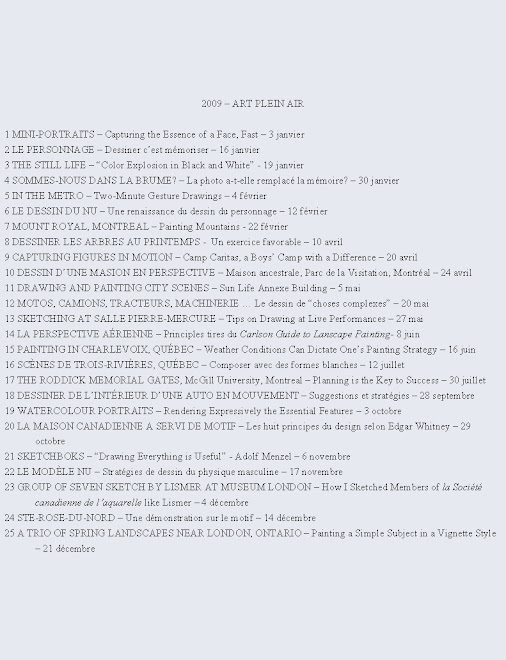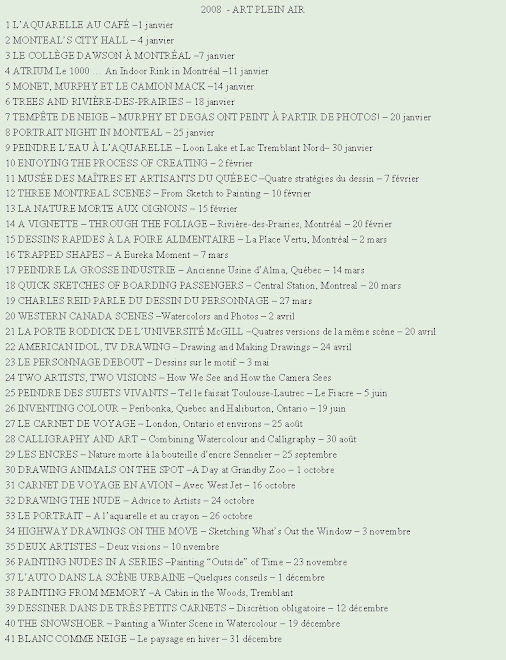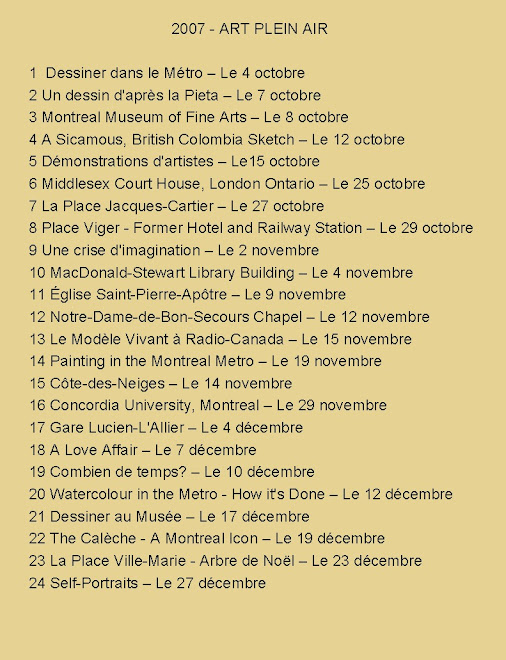Ten 20 minute portraits
As a member of la Sociéte canadienne de l’aquarelle I was invited to paint at the Montreal Museum of Fine Arts September 27th. I painted ten head portraits in an afternoon spending approximately twenty minutes on each. Painting quickly but precisely teaches one to zero in expressively on the essentials.
Three-quarter lighting
The model sat facing me at eye level. I set up three-quarter lighting from above and to one side of the front of the head. The lighting cast strong diagonal shadow shapes defining the features. The model was asked to stare at a fixed point away from me so that both of us would not be distracted.
The materials
Isabey Petit Gris natural hair brushes nos. 2/0, 1, 3 and 7; Isabey Kolinsky nos. 6 and 8; a folding metal Holbein palette; Holbein, Sennelier and Windsor & Newton pigments; Strathmore Aquarius II paper. Ultramarine Blue Dark, Burnt Sienna, Gold Ochre, Permanent Alizarin Crimson and Payne’s Grey tube pigments.
The procedure
With a 2B pencil I outlined the main feature shapes in five to seven minutes. Starting with the eyes, I precisely defined the shape of the pupil, eye shape, eye lid and the form of the shadow cast by the eye sockets. I then estimated the placement and shape of the nostrils from shadow shapes clues. A faint pencil line was drawn down the center axis of the nose to decipher its shape and limit. I concentrated on the shapes of the shadows more than the features. The same procedure applied to the chin and neck shapes.
Use an imaginary grid as a help
When painting a frontal portrait one can imagine a grid across the face. The limits of the mouth usually fall immediately below the pupil of the eye and the wings of the nose more or less align with the inner corner of the eye. The top of the ear is usually level with the eyes while its length is particular to the individual. Finally, I usually locate the length of the neck by drawing an imaginary horizontal line at the chin.
Concentrate on the peculiar
There are certain features and shapes one must render correctly in order to describe the peculiarity of the sitter. These are: the unique shape of the eyes and eyebrow area; the particular shape and length of the mouth including the width of the lips; the ovals of the nostrils; the correct angle of the chin/jaw; and finally the width, length and angle of the neck. The distance between the top of the cranium (not the hair) and the eyes should never be shorter than the distance between the eyes and the chin.
Final considerations
When painting in watercolor in one go it is especially important to know when to stop because it is almost impossible to make corrections especially in a loose watercolor rendering. Sometimes one stroke too many will cause the portrait to fail, so it is better to say less than to overdo. When I start hesitating that is usually my clue to stop. Finally, in order to add contrast or to connect the model to the edges of the paper I sometimes add background shapes.
Portrait night
With these tips in mind why not ask a friend or family member to pose? Aim for process rather than product; see shapes rather than features and your chance of success will increase a hundred fold. If you live in the Montreal area and wish to join my artist friends and I at Portrait night on Monday nights contact me at raynaldmurphy@hotmail.com for details.
Raynald Murphy sca








